Why Early Detection Is the Real Key to Fire Safety

When it comes to fire safety, most people immediately think about extinguishers, hoses, or evacuation plans. While all of these are essential, the single most critical element in preventing tragedy is time. Fires can spread incredibly fast — sometimes doubling in size every 30 seconds — and the difference between a contained incident and a catastrophic loss often comes down to how quickly a fire is detected. Early detection doesn’t just save property; it saves lives.
The Crucial Role of Early Warning
Every fire starts small. In its early stages, it can often be extinguished quickly with minimal damage, but as it grows, it becomes exponentially harder to control. That’s why detection — not reaction — is the real key to fire safety.
When a fire breaks out, the first few minutes are everything. Flames can spread through flammable materials, fill rooms with toxic smoke, and cut off escape routes in less time than it takes for emergency services to arrive. Early warning gives people the chance to act: to alert others, evacuate safely, and stop the fire before it takes hold.
This is where automatic fire detection systems come into play. These advanced technologies continuously monitor the environment for signs of smoke, heat, or flame, triggering alarms and often notifying authorities before humans even notice a problem. They’re designed to buy you time — and when it comes to fire, time is everything.
Why Early Detection Saves Lives
Statistics show that most fire-related deaths occur not from burns, but from inhaling toxic gases such as carbon monoxide. Smoke spreads faster than flames and can incapacitate people within minutes, especially while they’re sleeping.
Early detection systems can pick up the smallest hint of smoke long before it becomes visible or life-threatening. This means people are alerted while escape routes are still clear and before disorientation sets in. In residential settings, this could mean the difference between safely leaving the home and being trapped inside. In commercial or industrial buildings, where the number of occupants is larger, an early alarm ensures orderly evacuation rather than panic.
The value of an early warning system isn’t just in alerting occupants — it’s in enabling a faster response from firefighters. Every second shaved off the timeline of detection gives emergency services a better chance of controlling the blaze and minimising damage.
The Science of Fire Growth
To understand why early detection matters so much, it helps to know how a fire behaves. Fire development typically follows four stages:
- Ignition: This is when the fire starts, often caused by heat, sparks, or electrical faults. At this stage, the fire is small and easy to extinguish.
- Growth: Oxygen and fuel feed the flames, allowing them to spread rapidly. Temperatures can soar within seconds, igniting nearby objects.
- Fully Developed: The fire reaches its peak intensity, consuming everything flammable in its path. Structural damage begins, and conditions become unsurvivable.
- Decay: Once the fuel is exhausted, the fire starts to die down — but by this point, the damage is done.
Early detection targets the first two stages — before a fire becomes uncontrollable. Once a blaze reaches the “fully developed” stage, even the most advanced firefighting equipment can only do so much.
See also: Dental Innovations: Pioneering Techniques for a Healthier Smile
Types of Fire Detection Systems
There’s no one-size-fits-all approach to fire detection. Different environments require different technologies to ensure maximum effectiveness. Here are some of the main types of detection systems used today:
1. Smoke Detectors
The most common and cost-effective solution, smoke detectors are vital for homes, offices, and schools. There are two main types:
- Ionisation detectors – best for detecting fast-flaming fires.
- Photoelectric detectors – better at detecting smouldering fires, which produce a lot of smoke before flames appear.
Many modern detectors combine both technologies for all-around protection.
2. Heat Detectors
Instead of sensing smoke, these detectors respond to temperature changes. They’re ideal for areas where smoke or steam could cause false alarms, such as kitchens, garages, or workshops.
3. Flame Detectors
Used mostly in industrial and hazardous environments, flame detectors identify the unique wavelengths of light emitted by open flames. They’re highly sensitive and provide rapid detection even in outdoor or high-risk settings.
4. Gas Detectors
These are designed to sense flammable or toxic gases that could indicate combustion or a leak. They’re essential in facilities like refineries, chemical plants, or underground car parks.
5. Aspirating Smoke Detection Systems
These advanced systems draw air samples through a network of pipes, allowing them to detect even the faintest traces of smoke. They’re ideal for environments where early detection is critical, such as data centres, museums, or clean rooms.
Each system plays a unique role in providing layered protection. The best fire safety setups use a combination of technologies to detect multiple warning signs simultaneously.
The Human Factor: Awareness and Maintenance
Even the most sophisticated detection system is only as good as its maintenance. A surprising number of fire tragedies occur because alarms were disconnected, batteries were flat, or systems weren’t regularly tested.
Regular maintenance is non-negotiable. That means checking alarms monthly, replacing batteries at least once a year, and ensuring hardwired systems are inspected by a professional according to Australian Standards (AS 1851). For commercial properties, regular servicing is a legal requirement.
Equally important is educating people about fire awareness. Employees, tenants, and family members should all know what to do when an alarm sounds — where to go, how to use extinguishers, and when to call emergency services.
An early alarm is only effective if people respond to it correctly.
Common Causes of Fire and How Detection Helps
Understanding the common causes of fire helps highlight where detection plays its most vital role:
- Electrical faults: Faulty wiring or overloaded circuits can cause hidden fires behind walls. Smoke detectors can catch these incidents before they spread.
- Cooking accidents: Kitchens are the leading source of house fires. Heat detectors can identify sudden spikes in temperature without being triggered by normal cooking vapours.
- Heating equipment: Portable heaters and fireplaces can ignite nearby furniture. Early smoke detection gives warning before flames escalate.
- Industrial hazards: Sparks, flammable gases, or chemical reactions can ignite instantly. Specialised detectors like flame or gas sensors provide rapid alerts.
By targeting risk zones with the right detectors, you dramatically reduce the chances of a small incident becoming a disaster.
Beyond Buildings: Early Detection in Everyday Life
While we often think of fire detection in the context of homes or offices, early warning systems extend far beyond four walls.
- Vehicles: Many modern cars, buses, and aircraft now have built-in fire detection systems in engines and battery compartments.
- Public infrastructure: Tunnels, train stations, and airports rely on advanced smoke and heat detection to ensure rapid evacuation in emergencies.
- Bushfire monitoring: In Australia, early fire detection networks using satellites, cameras, and sensors play a vital role in spotting bushfires before they spread.
Each of these applications reinforces one truth — whether it’s a small spark or a massive blaze, the sooner you know, the safer you are.
The Future of Fire Detection
Technology is evolving rapidly, making fire detection smarter and more reliable than ever before. Artificial intelligence and the Internet of Things (IoT) are revolutionising the field.
AI-powered detectors can analyse patterns in smoke and temperature, reducing false alarms while improving sensitivity. IoT-connected systems can instantly alert homeowners or building managers via smartphone, even when they’re kilometres away. In commercial settings, integrated fire systems can automatically trigger sprinklers, shut down ventilation, and guide occupants to safety using illuminated pathways.
These innovations are turning reactive safety into proactive prevention.
Fire safety is often thought of as something you deal with after a fire starts — but the truth is, the real key lies in catching it early. From simple household alarms to cutting-edge industrial systems, early detection provides the most valuable resource of all: time. Time to act, time to escape, and time to save what matters most. A few seconds of warning can change everything, turning what could have been a disaster into a close call — and that’s why early detection will always be the heart of true fire safety.





